 Backend Development
Backend Development
 Python Tutorial
Python Tutorial
 Detailed example of how to implement a chatbot using Python+Slack API
Detailed example of how to implement a chatbot using Python+Slack API
Detailed example of how to implement a chatbot using Python+Slack API
Chatbot (Bot) is a practical interactive chat service like Slack. If you’ve never built a chatbot before, this article provides a simple introductory guide on how to build your first chatbot using Python and the Slack API.
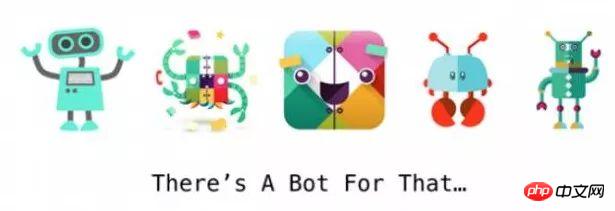
We build your development environment, obtain a Slack API chatbot token, and use Pyhon Develop a simple chatbot.
Tools we need
Our chatbot we’ll call it “StarterBot” requires Python and Slack API. To run our Python code we need:
Python 2 or Python 3
pip and virtualenv to handle Python application dependencies
A free Slack account with API access, or you can sign up for a Slack Developer Hangout team.
Official Python Slack client code base built by the Slack team
##Slack API Test Token
The Slack API documentation will be helpful as you build in this tutorial.
All the code in this tutorial is placed in the slack-starterbot public library and is open sourced under the MIT license.
Set up our environment
We now know what tools we need for our project, so let’s Let’s set up our development environment. First go to Terminal (or Command Prompt on Windows) and change to the directory where you want to store this project. In that directory, create a new virtualenv to isolate our application dependencies from other Python projects.

Your prompt should now look like the screenshot: Command prompt of activated starterbot's virtualenv This official slack client API help library is built by Slack, which can send and receive messages through Slack channels. Install the slackclient library via this pip command: When the pip command completes, you should see something like this output and returns the prompt. We also need to get the output of installing slackclient with pip in the activated virtualenv for our Slack project An access token so that our chatbot can use it to connect to the Slack API. Slack Real-Time Messaging (RTM) API Slack allows programs to access their messages through a Web API Delivery channel. Go to this Slack Web API page to register and build your own Slack project. You can also log in to an existing account that you have administrative rights for. After logging in using the login button in the upper right corner of the Web API page you will arrive at the chatbot user page. Customize Chatbot User Page Name your chatbot "starterbot" and click "Add bot integration" button. Add a bot integration and name it "starterbot" The page will reload and you will see a newly generated visit Token. You can also change the logo to one of your own design. For example I gave this "Full Stack Python" flag. A common practice among Python developers is to export the secret token as an environment variable. The name of the output Slack token is SLACK_BOT_TOKEN: We need one more piece of information to build our chatbot: our chatbot’s ID. Next we'll write a short script to get that ID from the Slack API. Getting the ID of our chatbot It’s finally time to write some Python code! Let’s write a A short Python script to get the StarterBot's ID to warm up. This ID varies based on the Slack project. We need this ID to authenticate our application when parsing messages sent to StarterBot from Slack RTM. Our script will also test whether our SLACK_BOT_TOKEN environment variable is set correctly. Create a new file named printbotid.py and fill in the following code: Our code imports SlackClient and instantiates it with the environment variable SLACK_BOT_TOKEN we set. When the script is executed via the python command, we access the Slack API to list all Slack users and get an ID matching the name "satrterbot". We only need to run this script to get the ID of the chatbot once. Coding our StarterBot Now we have everything we need to write the code for our StarterBot. Create a new file named starterbot.py and include the following code. Through the dependency packages we imported, we can use them to obtain environment variable values and instantiate the Slack client. Next add two functions to parse Slack’s output and process commands. This is how the entire program looks together (you can also view the file in GitHub) : When StarterBot starts running and the output channel connected to the API creates a new channel in Slack and puts Invite StarterBot in, or invite StarterBot into an existing channel. End Okay, you now have a simple chatbot that you can do a lot in code place to add any features you want to create. We can do a lot of things using the Slack RTM API and Python. See what else you can learn through these articles: #Attach a persistent relational database or NoSQL backend such as PostgreSQL, MySQL or SQLite to save and Retrieve user data Add another channel to interact with the chatbot, such as text message or phone call Integrate other web APIs, such as GitHub, Twilio or api.ai


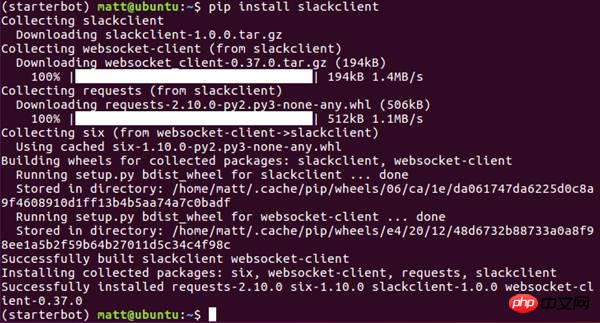
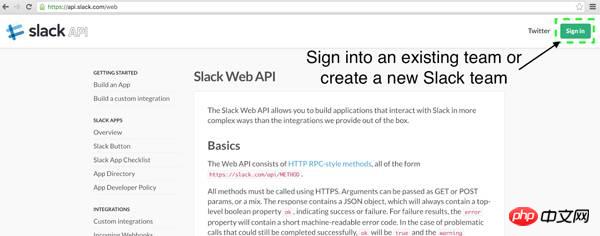


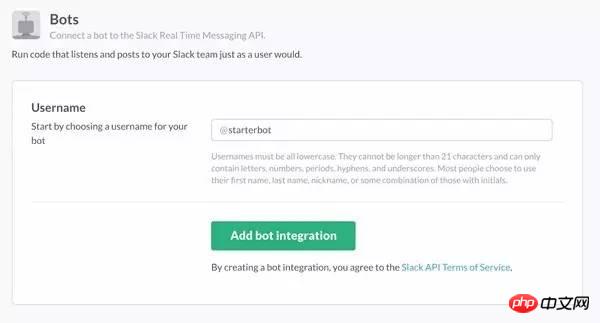
Copy and paste the access token for your new Slack chatbot Click at the bottom of the page "Save Integration" button. Your chatbot is now ready to connect to the Slack API. 
Okay, we now have authorization to use this Slack API as a chatbot. 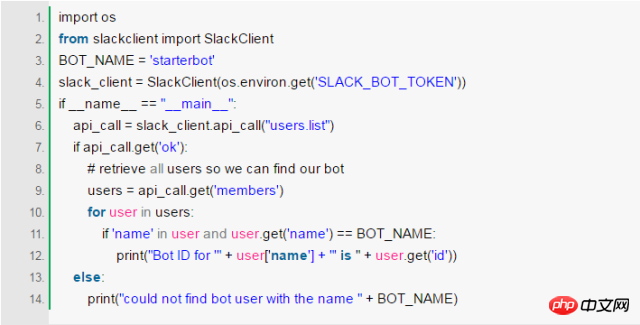

When it runs giving us the ID of the chatbot, the script prints out a simple one line of output. 
Use a Python script in your Slack project to print the ID of the Slack chatbot. Copy the unique ID printed by this script. And output the ID as an environment variable BOT_ID. 
This script only needs to be run once to get the chatbot’s ID. We can now use this ID in our Python application running StarterBot. 
The import of os and SlackClient looks familiar because we have already used them in theprintbotid.py. 
This code instantiates the SlackClient` client through the environment variable SLACK_BOT_TOKEN we exported. 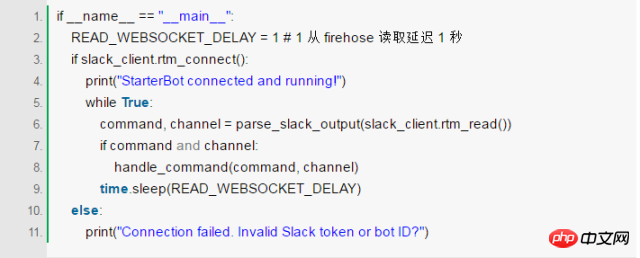
The Slack client connects to the Slack RTM API WebSocket and then loops continuously while parsing messages from firehose. If there are any messages sent to the StarterBot, a function called handle_command determines what to do. 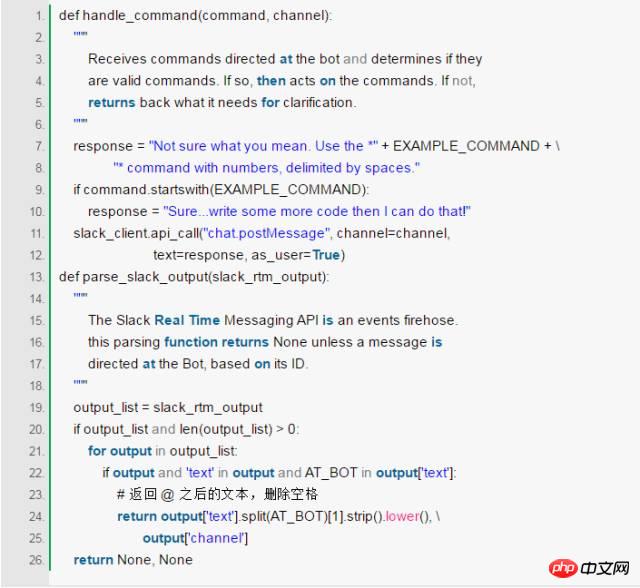
The parse_slack_output function accepts messages from Slack and determines if they were sent to our StarterBot. The message starts with a direct command to our chatbot ID and is then handed off to our code for processing. Currently, I just publish a message through the Slack pipeline to tell the user to write more Python code! 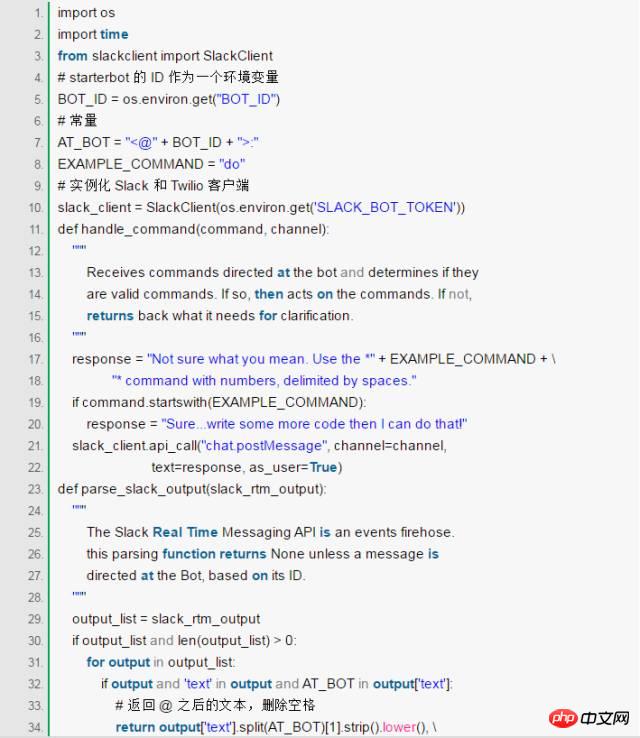
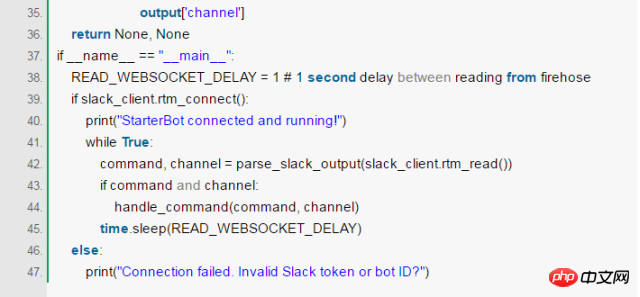
##Now that our code is there, we can run our StarterBot through python starterbot.py code. 
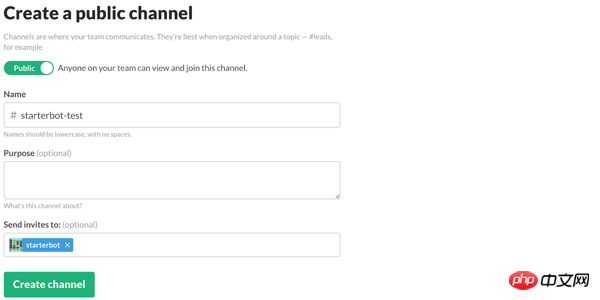
Create a new channel in the Slack interface and invite StarterBot. Now send commands to StarterBot in your channel. 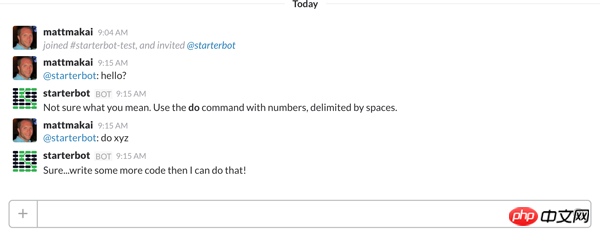
Send commands to your StarterBot in your Slack channel If you are having issues getting responses from your chatbot, you may A modification needs to be made. As written above for this tutorial, the line AT_BOT = “:” requires a colon after “@starter” (the name you gave your own chatbot). Remove: from the end of the AT_BOT string. Slack seems to require a colon after @ a person's name, but this seems a bit incongruous.
The above is the detailed content of Detailed example of how to implement a chatbot using Python+Slack API. For more information, please follow other related articles on the PHP Chinese website!

Hot AI Tools

Undresser.AI Undress
AI-powered app for creating realistic nude photos

AI Clothes Remover
Online AI tool for removing clothes from photos.

Undress AI Tool
Undress images for free

Clothoff.io
AI clothes remover

AI Hentai Generator
Generate AI Hentai for free.

Hot Article

Hot Tools

Notepad++7.3.1
Easy-to-use and free code editor

SublimeText3 Chinese version
Chinese version, very easy to use

Zend Studio 13.0.1
Powerful PHP integrated development environment

Dreamweaver CS6
Visual web development tools

SublimeText3 Mac version
God-level code editing software (SublimeText3)

Hot Topics
 Xiaohongshu begins testing AI chatbot 'Da Vinci'
Jan 15, 2024 pm 12:42 PM
Xiaohongshu begins testing AI chatbot 'Da Vinci'
Jan 15, 2024 pm 12:42 PM
Xiaohongshu is working to enrich its products by adding more artificial intelligence features. According to domestic media reports, Xiaohongshu is internally testing an AI application called "Davinci" in its main app. It is reported that the application can provide users with AI chat services such as intelligent question and answer, including travel guides, food guides, geographical and cultural knowledge, life skills, personal growth and psychological construction, etc. According to reports, "Davinci" uses the LLAMA model under Meta A product for training, the product has been tested since September this year. There are rumors that Xiaohongshu was also conducting an internal test of a group AI conversation function. Under this function, users can create or introduce AI characters in group chats, and have conversations and interactions with them. Image source: T
 How to develop an intelligent chatbot using ChatGPT and Java
Oct 28, 2023 am 08:54 AM
How to develop an intelligent chatbot using ChatGPT and Java
Oct 28, 2023 am 08:54 AM
In this article, we will introduce how to develop intelligent chatbots using ChatGPT and Java, and provide some specific code examples. ChatGPT is the latest version of the Generative Pre-training Transformer developed by OpenAI, a neural network-based artificial intelligence technology that can understand natural language and generate human-like text. Using ChatGPT we can easily create adaptive chats
 Why Chatbots Can't Completely Replace Humans
May 09, 2023 pm 12:31 PM
Why Chatbots Can't Completely Replace Humans
May 09, 2023 pm 12:31 PM
The Importance of Creativity, Empathy, and Authenticity in Customer Service and Writing In this blog post, we discuss the pros and cons of using chatbots in the customer service and writing industry. While chatbots can provide fast and accurate responses to customer inquiries, they lack the creativity, empathy, and authenticity that human writers and customer service representatives possess. We will also discuss the ethical issues surrounding the use of chatbots and artificial intelligence in general. Overall, chatbots should be viewed as a complement rather than a replacement for human labor. Learn more about the role of chatbots in the workforce in this article. I understand the concerns many people have about the potential of AI to replace human workers. Specifically, there has been speculation about the potential for chatbots to replace human customer service
 How to develop an AI-based smart chatbot using Java
Sep 21, 2023 am 10:45 AM
How to develop an AI-based smart chatbot using Java
Sep 21, 2023 am 10:45 AM
How to use Java to develop an intelligent chatbot based on artificial intelligence. With the continuous development of artificial intelligence technology, intelligent chatbots are becoming more and more widely used in various application scenarios. Developing an intelligent chatbot based on artificial intelligence can not only improve user experience, but also save labor costs for enterprises. This article will introduce how to use Java language to develop an intelligent chatbot based on artificial intelligence and provide specific code examples. Determine the function and domain of the bot. Before developing an intelligent chatbot, you first need to determine
 Xiaohongshu internally tests Da Vinci AI chatbot 'Davinic'
Jan 05, 2024 pm 10:57 PM
Xiaohongshu internally tests Da Vinci AI chatbot 'Davinic'
Jan 05, 2024 pm 10:57 PM
News from ChinaZ.com on December 25: According to Tech Planet, Xiaohongshu has internally tested an AI function called “Davinic” in its main APP. This function has been tested since September and is still ongoing. This is also another new AI application launched by Xiaohongshu after the AI group chat. "Davinic" mainly provides users with AI chat functions such as intelligent question and answer. "Davinic" is more focused on providing questions and answers about the good life, including travel guides, food guides, geographical and cultural knowledge, life skills, personal growth and psychological advice, as well as activity recommendations and other fields. According to reports, "Davinic" is based on LLAMA large model under Meta
 How Enterprises Use ChatGPT and GPT-3
Apr 12, 2023 pm 10:49 PM
How Enterprises Use ChatGPT and GPT-3
Apr 12, 2023 pm 10:49 PM
Chatbot platforms like ChatGPT and GPT-3 are valuable tools for automating functions, creating creative ideas, and even writing new code and providing fixes for broken applications, but there are some precautions that need to be taken before enterprises adopt them. For businesses, chatbots like ChatGPT have the potential to automate routine tasks or enhance complex communications, such as creating email sales campaigns, modifying computer code, or improving customer support. Research firm Gartner predicts that the global artificial intelligence software market will reach US$134.8 billion by 2025, and the market growth rate is expected to increase from 14.4% in 2021 to 31.1% in 2025, far exceeding the overall software market.
 Supports Chinese dialogue! New NVIDIA ChatRTX updated
Jun 09, 2024 am 11:25 AM
Supports Chinese dialogue! New NVIDIA ChatRTX updated
Jun 09, 2024 am 11:25 AM
As early as February, NVIDIA launched the LLM-based chatbot ChatwithRTX. In May, the chatbot was updated, adding new models and new functions, the packaging package was also reduced from 35G to 11G, and the software was officially renamed ChatRTX. In the previous article and video about ChatwithRTX, we mentioned that ChatwithRTX does not have its own Chinese reply. If you want to implement Chinese answers, you need to install your own environment, large language models, etc. But this step has a relatively high threshold for users, and they have to go through many complicated steps to achieve Chinese question and answer. Before the introduction, let’s briefly talk about what ChatRTX is.
 Would you like to open up to an AI therapist?
May 02, 2023 pm 09:28 PM
Would you like to open up to an AI therapist?
May 02, 2023 pm 09:28 PM
We are increasingly turning to smart voice assistants or chatbots on websites and apps to answer questions. As these systems powered by artificial intelligence (AI) software become more sophisticated, they start to provide pretty good, detailed answers. But will such a chatbot be as effective a therapist as a human? Computer programmer Eugenia Kuyda is the founder of US chatbot app Replika, which says it provides users with a "caring AI companion, always here to listen and talk, always by your side". It was launched in 2017 and currently has over 2 million active users. Each person has a voice unique to them as the AI learns from their conversations





